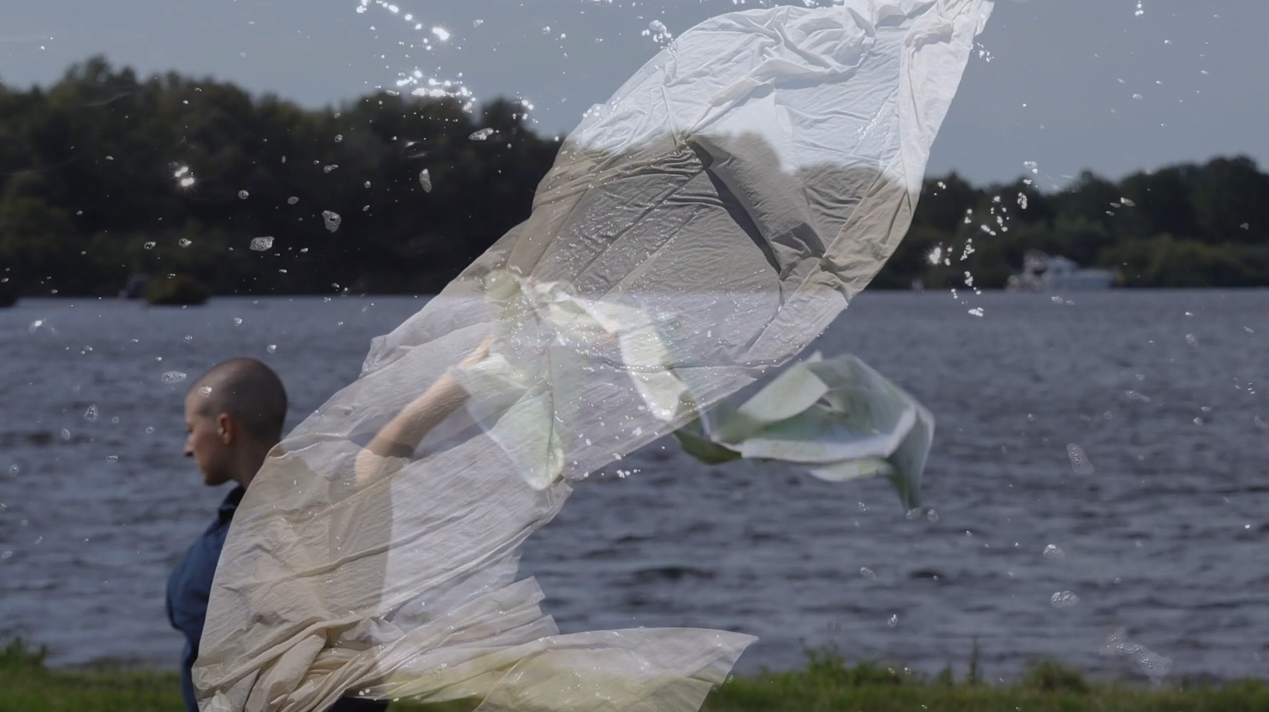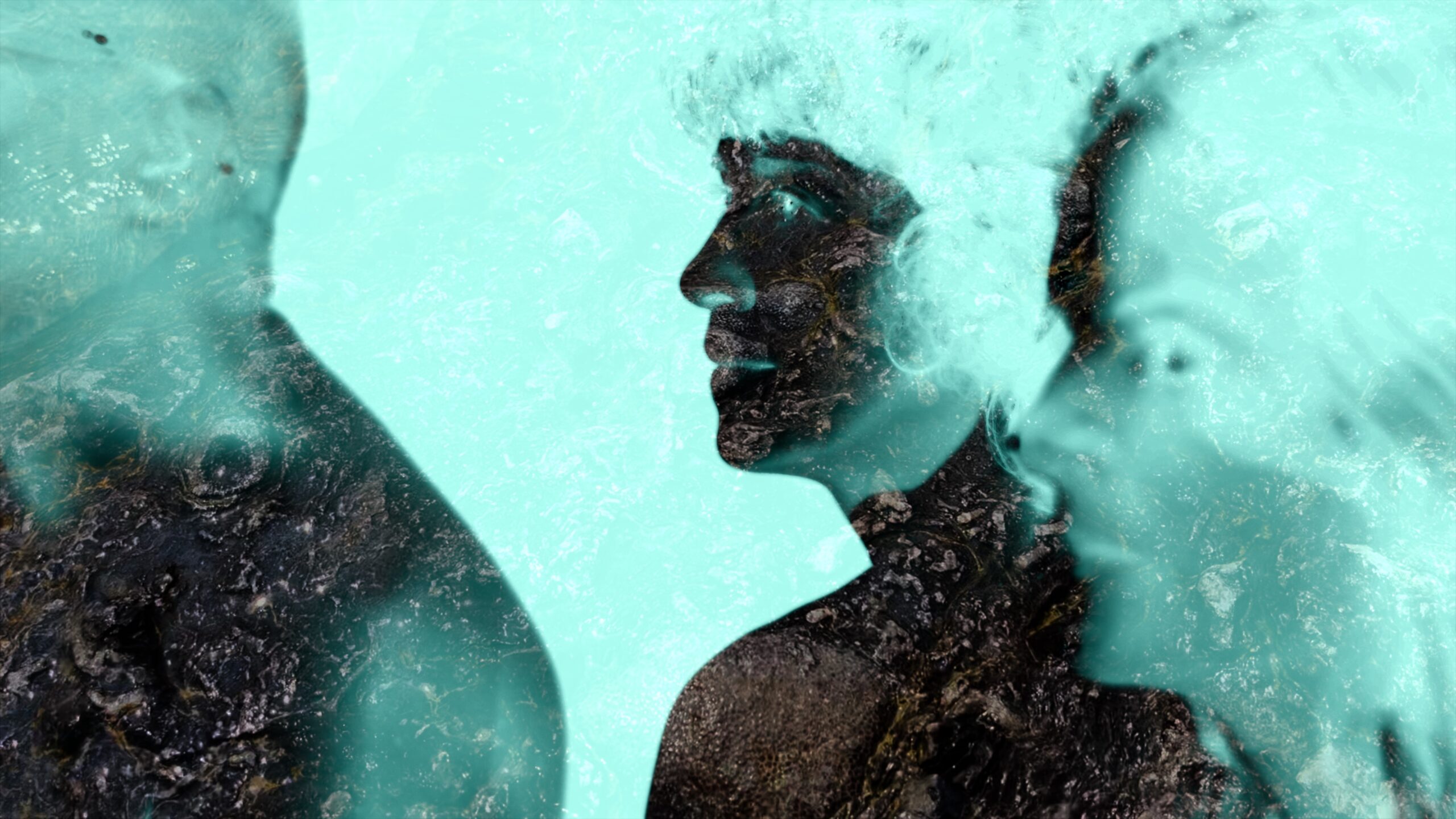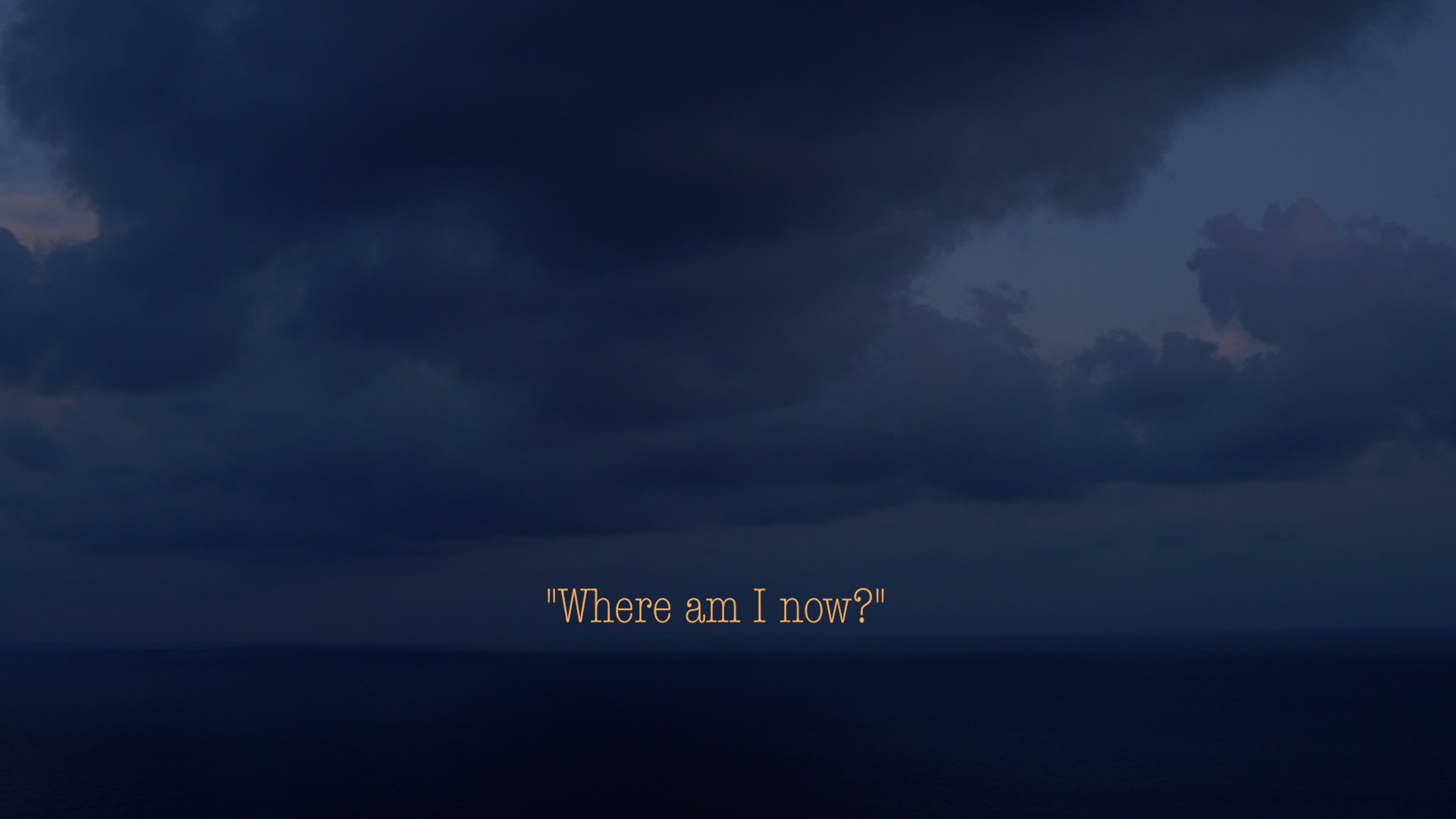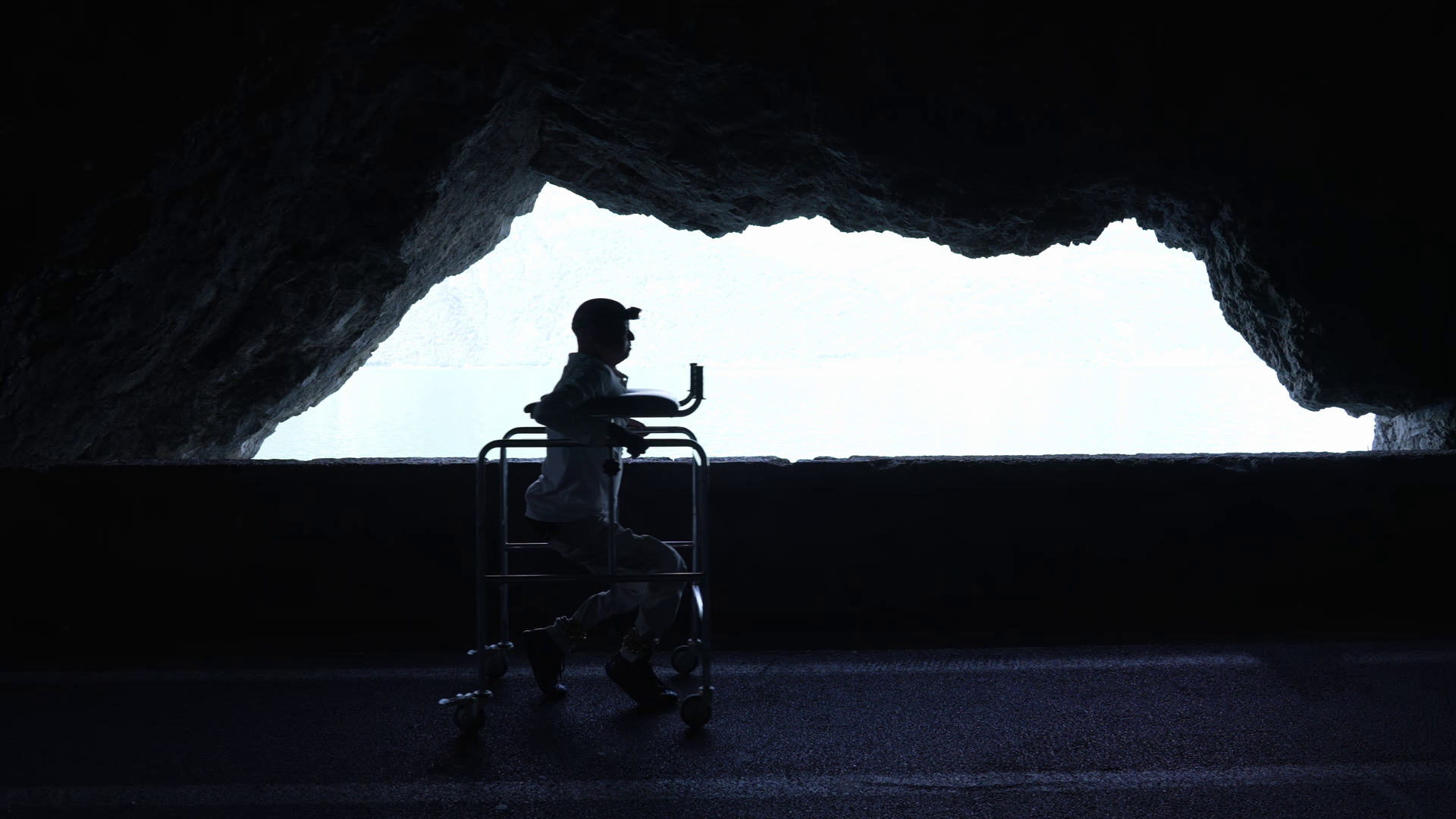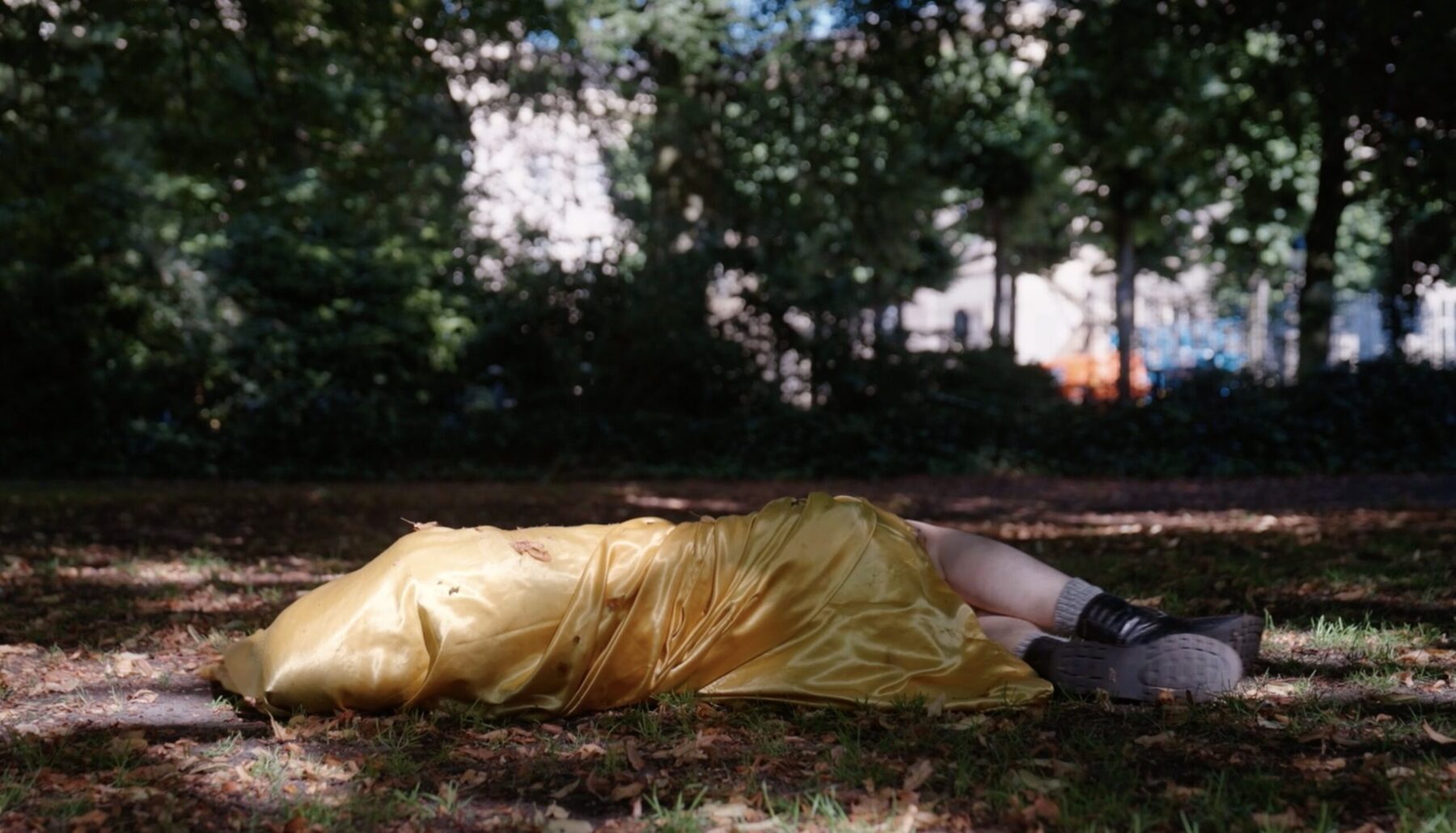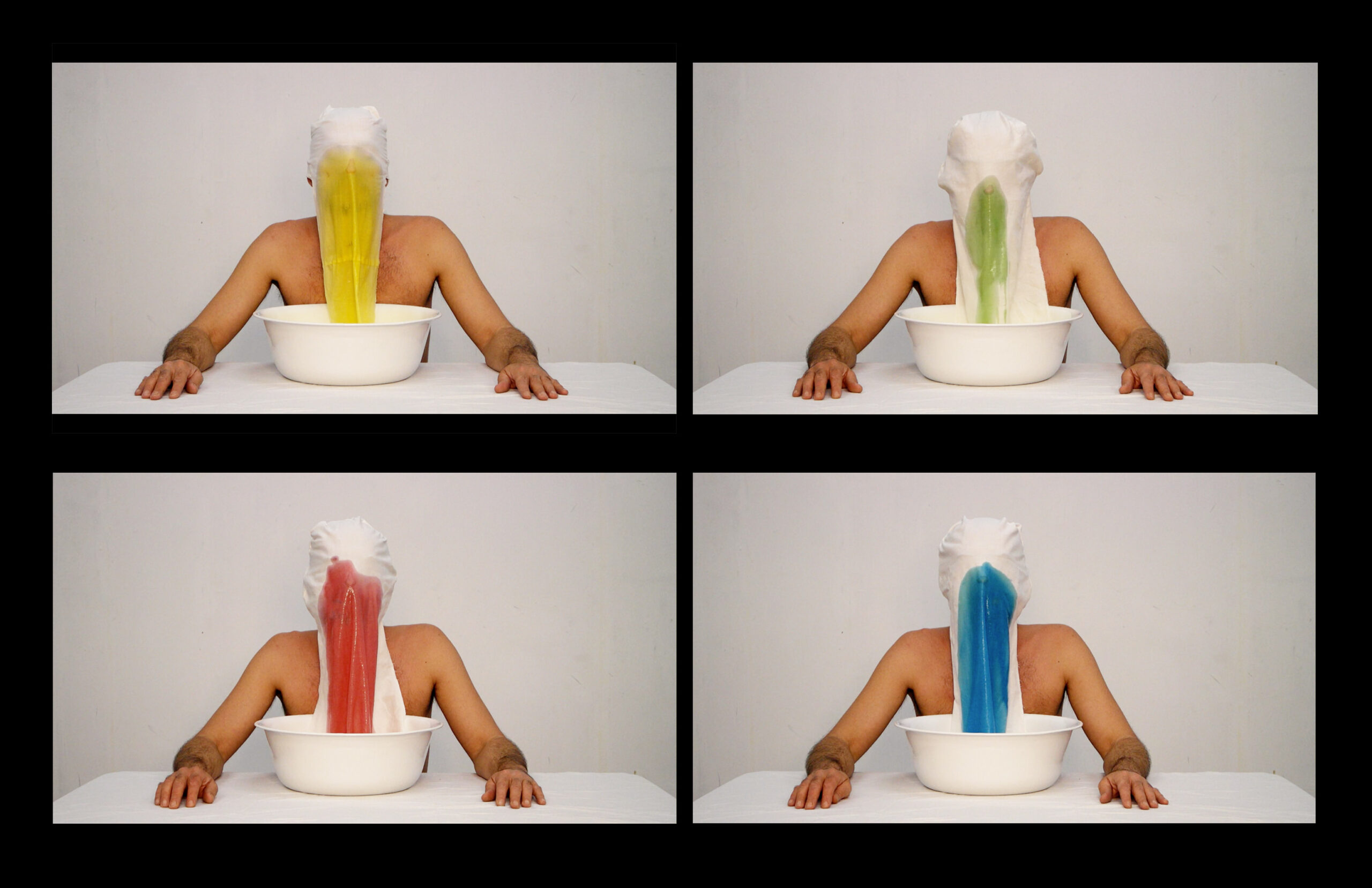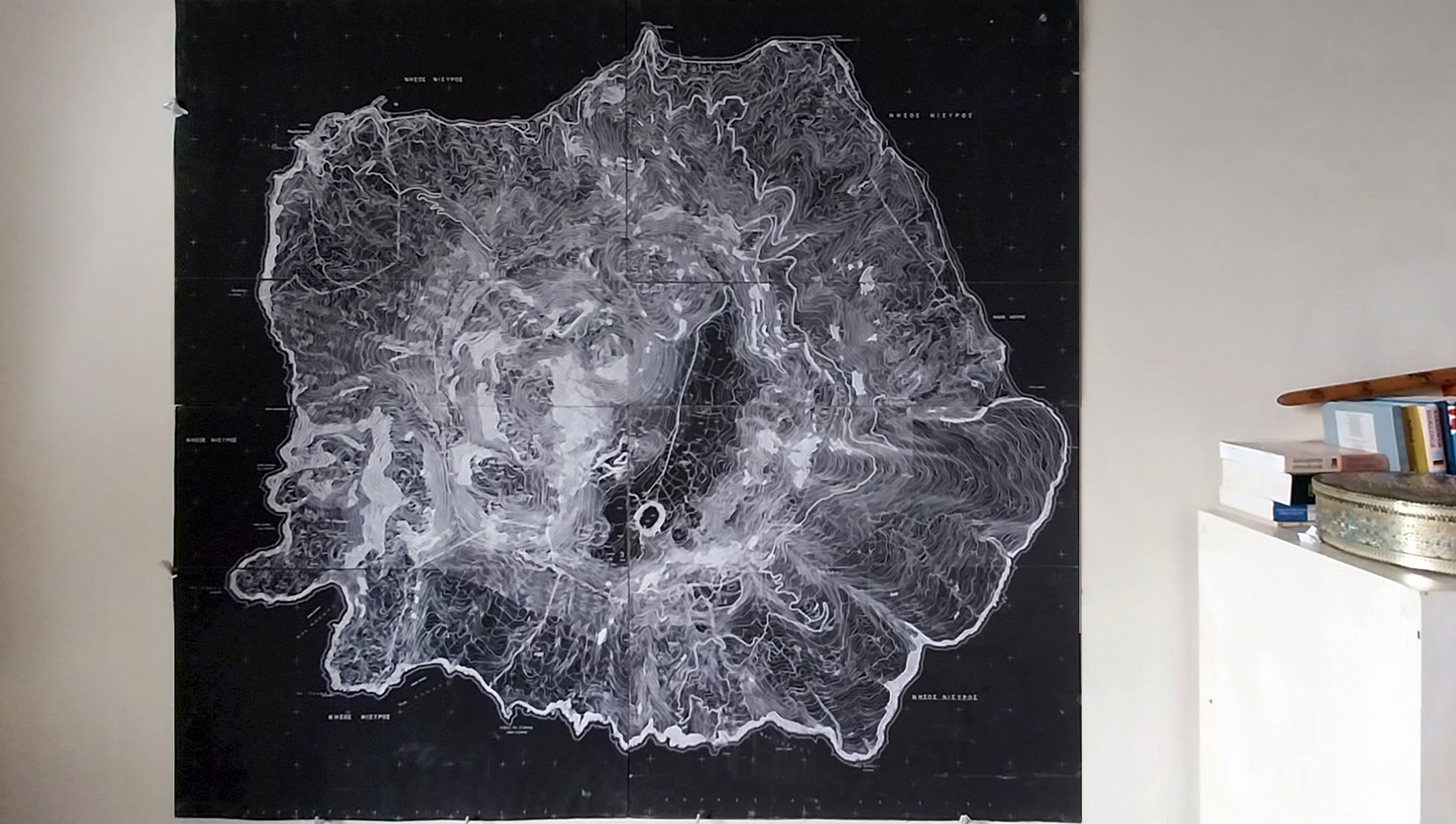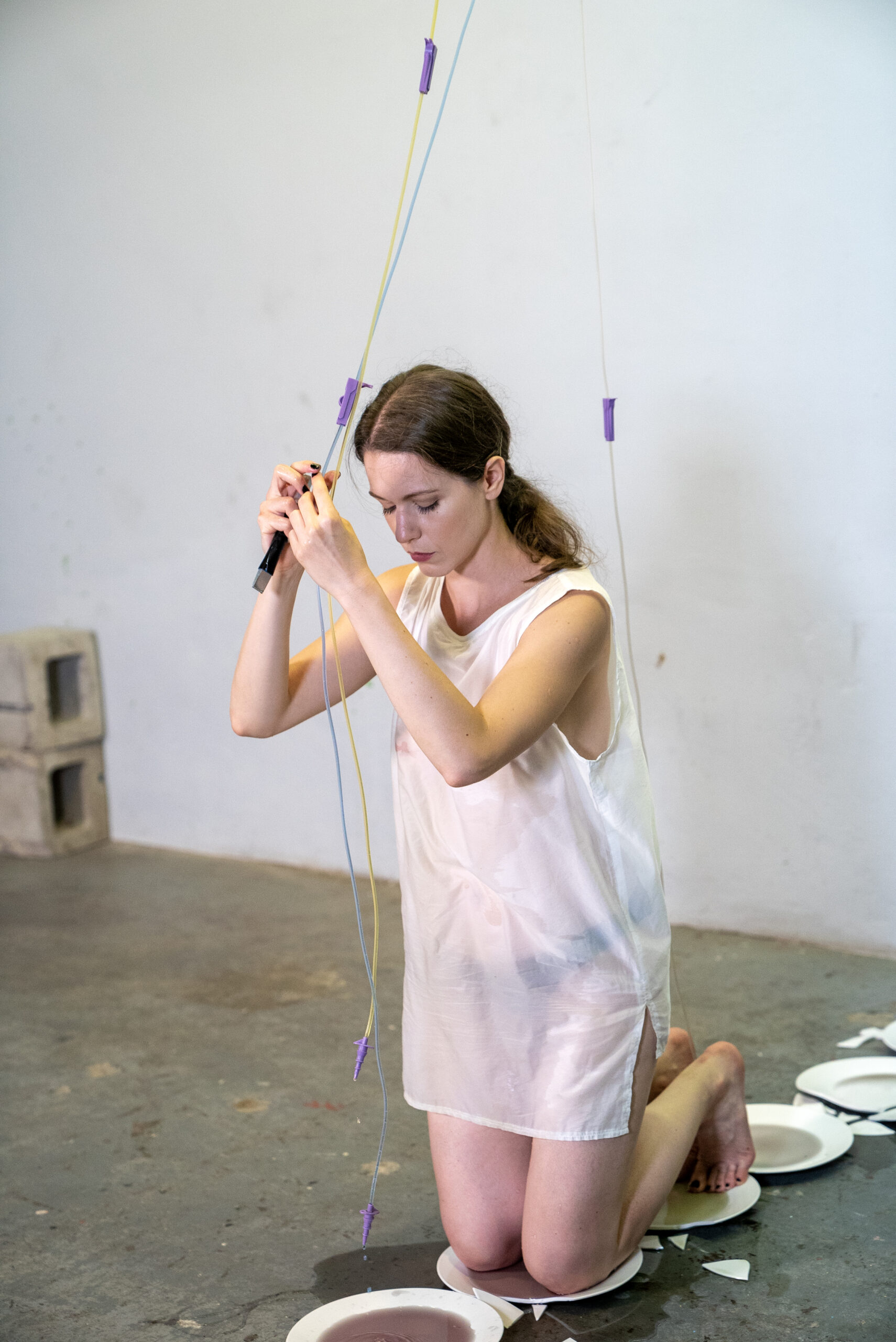Artists-in-residences
DIGILABAIR 2023
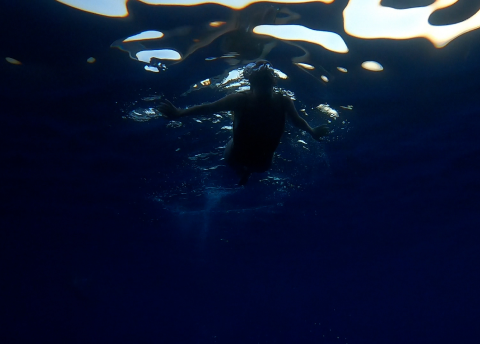
A note from PAV’s artistic director
Digital Lab Artist-in Residences (DigiLabAiR) is performance-based video art project realised by PAV in partnership with five European no-profit cultural associations with territorial solid knowledge of performance art and Live art and anchoring in participatory co-creation processes.
Co-founded by the European Union, the project consist of five Digital Artist-in Residences hosting three artist and one curator each, who have been invited to produce three video works thematising social issues framed in the Social Development Goals agenda (SDGs).
Each residence has been conceived as a place of thought, research, and experimentation for ideas to grow and develop in ways the invited artists feel need.
EntrAxis e.V. (Germany)
On Climate Emergency
The disappearing home, flooded by the rising sea levels. The tidal feeling of solastalgia,
the homesickness when you are still at home, but you know it’s under threat and will one day be taken by the water.
Areas created and protected by human efforts from encroaching waters are not just a home for people but also for a diverse ecosystem. The video’s performer, Steef Kersbergen, learned as a child that their hometown in the Netherlands would flood irredeemably and, with it, a third of the country. The precise timeline of this event remains uncertain, with scientists offering varying estimates.
The Dutch people are divided in dealing with this eventuality. Some are preparing. Others sit with or suppress the discomfort, push away the water, fear, grief, and sadness and continue living. As for now, it is okay.
Becoming Fossil invites viewers to become time travelers through kaleidoscopic sensations of touch and elemental change. Join in and travel backward and forward in time around our small precious planet. Ride the waves of climate emergencies and experience both extinction and resiliency in human and more-than-human touches.
The last walk to a melting glacier and the rituals of walking the moist ground it reveals by leaving. Things to carry with oneself on wounded paths and singing to the ancient frozen imprints disappearing into the memory of algal blooms sprouting in the warm seas. A journey on foot, connecting homes across the nomadic landscapes of borrowed belonging. A body alive, in the haunts of breaking ice.
Studio Contemporaneo (Italy)
On Migration
It has been 112 years since one single building in Tbilisi has stood as a silent witness to the passage of time, hosting countless generations, families, and lives. Facing all wars, national catastrophes, economical disasters and other troubles throughout all of its life, now it is the time for it to bid farewell to the 19 families who have called it home, as it prepares to be consigned to history forever.
After the temporary relocation the residents of the building will return to the same pin on the map but to a newly built apartment block.
The movie is made by Sabrina Bellenzier and Giorgi Rodionov, who explore the migration of memories from home to home at the same location, where the new inhabitants become the ghosts of the ruins the new home was built on.
This project was developed in collaboration with Untitled Tbilisi, an art organisation that has been an integral part of the house for years, further emphasising the connection between the building and the creative work surrounding it. The film appears to be a reflection on the passage of time, the continuity of memory, and the transformation of physical spaces.
“I’m here, inside me. I’m always moving. My home is myself.”
Everything rotates around the question: “Where are you now?” Those who ask this question may also look for coordinates for themselves. A silent voice moves along the moving images. Thoughts about being and belonging to oneself are juxtaposed over natural landscapes—nature itself. Movement is the constant that binds the bodies. There is a need to visualise the self and others geographically to acknowledge the tangible existence of things. The sea is the protagonist—water’s continuous flow, water as life and death, the element and place to start a journey, a part of a journey, a little fragment of life. Again.
An abandoned NATO base built during the Cold War on a mountain pass linking three valleys to each other in north Italy. Old business lines, passageways and other morphological peculiarities. Sound waves, cymbal vibrations and fake animal puppies mark an imaginary sense of the time passing. The landscapes around take on ascetic and fleeting colours. Those zones that were once controlled from now on are a way out. The senses conjugate an escape trajectory from the body to the sky. The video consists of three chapters. Each of them begins with a description of emotions.
The story develops through symbols concerning identity, presence, existence and condition. Documentary scenes alternate with anatomical frames. Keeping direction straight on, the protagonist discovers new territories—nowhere is everywhere.
He trespasses and tracks them down with his orthopaedic devices, migrating from a tunnel’s darkness to the light, like a miner who reaches the surface after spending endless moments in the depths of the earth where the rumble of metal makes its way through the rocks.
ECC Performance Art (Netherlands)
On Social Inclusion
When you are housebound, you become mainly invisible to the world. Unable to participate in the daily activities that happen outside the door of your home, it is easy to start feeling like you don’t exist. In The Struggle for Visibility, the artist attempts to become part of the outside world. They are covered in a golden silk sheet and stay close to the ground to represent their ongoing separate reality as chronically ill. In the public space, they become hyper-visible whilst remaining largely hidden from view. In their dreams of belonging to the outside world, they desperately try to overcome all the barriers it poses. In the last attempt to become more visible, they climb the highest stairs in the busiest part of town, but they find that this is too much to ask of their fragile body. Also, it does not lead to the meaningful social engagement they had wished for. Instead, they end up alone, exhausted by the effort of trying. For sick and disabled bodies to become more visible in public spaces, we need societies to adapt to our needs rather than push ourselves to become more visible to society.
Only by undergoing abuse do I now see it around me all the time—not only the abuse I experienced but also racism, gender inequality, abuse of the planet and the underlying structures of power. What strikes me in my waking up process is that the victims of whatever abuse suffer silently. Speaking up about it doesn’t help most of the time because people don’t believe you or tell you it wasn’t all that bad, whereby they are causing extra harm and isolation. I understand this mechanism of disbelief now. If you acknowledge abuse, you must step out of your comfort zone and leave behind this false sense of security. You have to take responsibility. Most people won’t do this. I stepped out of the groove—I cannot be silence(d) anymore.
For centuries, the Mediterranean Sea has occupied a central place in the evolution of human society and Europe. It is both a physical barrier to human mobility and an element that connects land and continents. Odysseus pursued his hero’s journey around the Mediterranean basin. Today, the Mare Nostrum is a precarious, tragic space where immigrants, attracted by the siren’s song of salvation and sanctuary in Europe, embark on a perilous journey that could lead them to exclusion or inclusion. The word siren stems from the Greek σειρά (seirá: rope, cord) and εἴρω (eírō: to tie, join, fasten), resulting in the meaning of the one who binds or entangles. Therefore, the siren will knot deceptive nets of blood-red ropes on the Mediterranean seashore, ultimately leaving them behind. Whether they stay there to protect or imprison, for salvation or damnation remains unclear.
Vittorio Venturoli writes this performative piece brings one to reflect on the dual relationship of migrants with the Mediterranean. Vehicle of migrations, the sea is numb and neutral in its endless role of levelling, smoothening edges, softening, tie after tie, even the sharpest will. Even the loudest storms are muted with time into a still, quiet fairness. It never alters the motion of its impartial ruling. And so, as guardians, instruments of its blind justice, the sirens weave the net of its will, enveloping wanderers, conquerors and fugitives. The performer embodies the siren—the tool of its choice, the voice of the waves, an ambiguous
[MIND THE] G.A.P. - GATHERING AROUND PERFORMANCE (Greece)
On Body and Citizenship
A stray dog that has been given a name has a far greater chance of survival.— Hannah Arendt
The core themes of this performance for the camera are the problem of moral principles and the relationship of the body to citizenship from the perspective of Stoic philosophy. Stoicism (a school of Hellenistic philosophy that flourished in Ancient Greece) focuses on human nature as part of universal nature and cosmic sympathy: the sense that the universe is an indivisible living organism, always in flux. Concurrently, the video is accompanied by an evocative depiction of an individual’s distress, serving as a poignant reminder that rights are achieved through united efforts and resilience during periods of oppression, devastation, and lamentation. Pappas’s artistic endeavour seeks to capture the essence of existential unease within today’s civilization. By weaving together individual and collective human and non-human connections with concepts encompassing the body, citizenship, space, time, mysteries, and the opposition utopia/dystopia, Universal Rights i.e. Naked Statelessness, deploys the camera as a vehicle for testimony and documentation. It deciphers a contagious and symbolic discourse, functioning as a mechanism to challenge the prevailing inclination towards the uniformity of thought and behaviour.
A video performance with a spoken text as a by-product of the “Treaty on European Union” and the “Treaty establishing the European Community”. Only the paragraphs, articles and points containing the word Enossis (Union) have been saved from the original texts of the treaties. All terms like bank, banking, ECB (European Central Bank), chapter, costs, country, economic, European, fees, government, governmental, international, market, monetary, nation, national, NATO (North Atlantic Treaty Organization), people, and state have been removed. Without adding or replacing phrases and words (except changing grammatical issues where required for the Greek language), the new text dismantles the institutional character of its members (Member States-Nations) and the central economic/monetary profile underlying the constitution of the European Community. The video is a comment on the nature of the mother tongue since it has to be read so that the missing words will not affect the pronunciation of the terms that follow them. The new ENOSSIS text seems more akin to a humanist manifesto than an economic and monetary treaty.
G12Hub (Republic of serbia)
On Gender Equality
Concept delves into the notion of notifications and social media becoming our sustenance, our daily food, and a captivating addiction that consumes our lives, shedding light on our modern habits and obsessions.
Performance challenges our reliance on technology and explores the impact on our senses. Breaking 12 plates symbolizes a year and time passed in our digital dependencies. Background notification soundscape reminds us of the constant stream of information we face daily, while the dripping water represents emotional complexity and the paradox of our insatiable thirst for connection. The performance prompts reflection on our relationship with technology, its effect on sensory experiences, and the content we consume. Through broken plates, notification noises, and dripping water, it calls for deeper, more meaningful connections and conscious consumption.
Performance turns a regular medical ritual performed by an artist in his private life into an action, representing the continuing process of repetitive life events that also shape us as people (and there is a question about how much we let them shape us?).
This is a story of personal saviour, solitude, inner thoughts colliding, transition, mental and physical health, strength, and ultimately, an interest in how we can turn a forever occurring event into an artistic ritual.
“Mrs. Dalloway said she would buy the flowers to herself”
Virginia Woolf, Mrs. Dalloway
12 sempreviva seeds were grown at Belgrade balcony and after two months of adaptation, they were adopted by 12 women.
This is a tribute to all women, to remind them that their “invisible” interior is their brightest aura.
This movie shows the love we carry in the unique existence of a female body and soul, which is the main key to the eternal flame.
